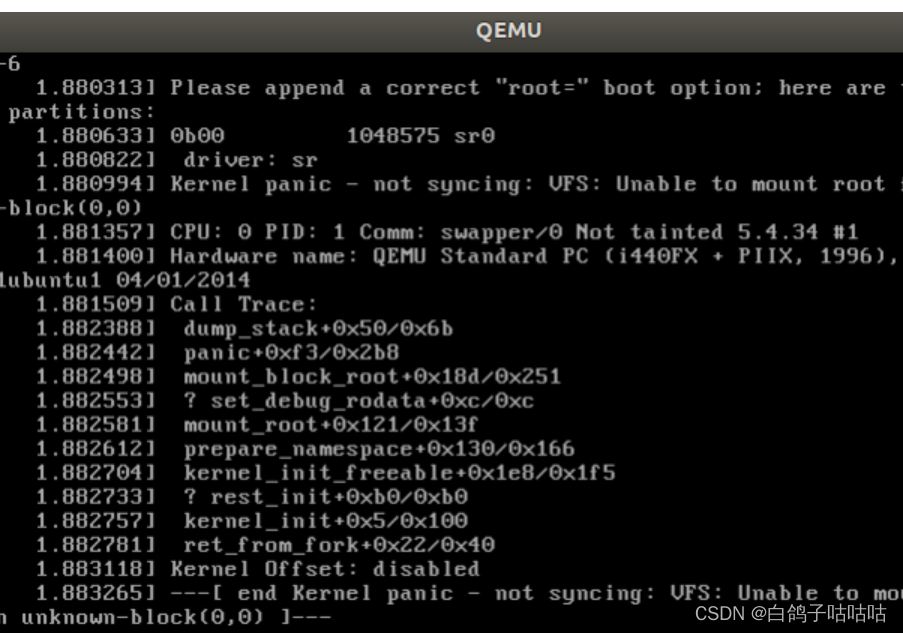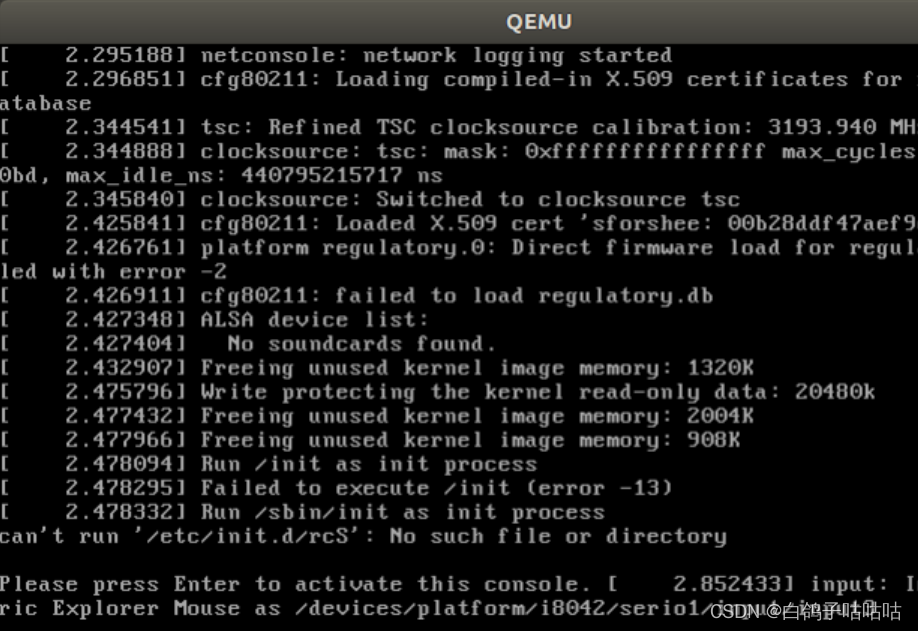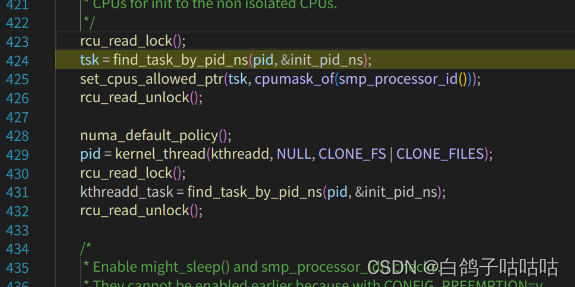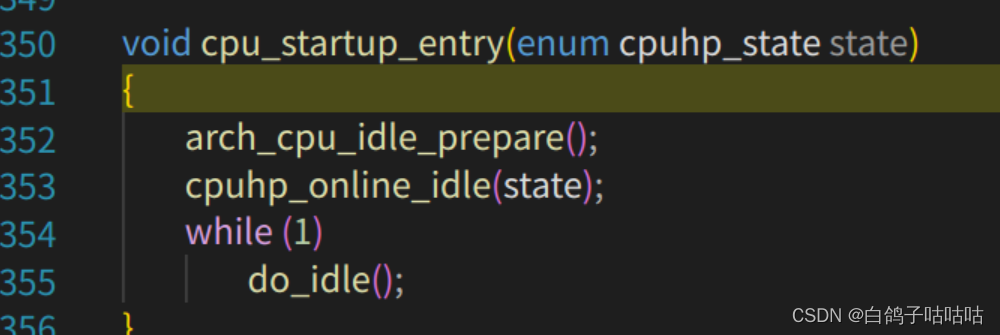环境:ubuntu-18.04.6(ubuntu 22.04真的是坑,之前坐别的实验就容易报一堆错误,换低级版本18和20就没那些问题,这次看同学用22.04的又是一堆报错)
安装开发工具
sudo apt install build-essential
sudo apt install qemu # install QEMU
sudo apt install libncurses5-dev bison flex libssl-dev libelf-dev
下载内核源代码
sudo apt install axel
axel -n 20 https://mirrors.edge.kernel.org/pub/linux/kernel/v5.x/linux-5.4.34.tar.xz
xz -d linux-5.4.34.tar.xz
tar -xvf linux-5.4.34.tar
cd linux-5.4.34
配置内核选项
make defconfig # Default configuration is based on 'x86_64_defconfig'
make menuconfig
打开debug相关选项
Kernel hacking --->
Compile-time checks and compiler options --->
[*] Compile the kernel with debug info
[*] Provide GDB scripts for kernel debugging
[*] Kernel debugging
关闭KASLR,否则会导致打断点失败
Processor type and features ---->
[] Randomize the address of the kernel image (KASLR)
编译和运行内核
make -j$(nproc) # nproc gives the number of CPU cores/threads available
编译和运行内核
qemu-system-x86_64 -kernel arch/x86/boot/bzImage

制作根文件系统
电脑加电启动首先由bootloader加载内核,内核紧接着需要挂载内存根文件系统,其中包含必要的设备驱动和工具,bootloader加载根文件系统到内存中,内核会将其挂载到根目录/下,然后运行根文件系统中init脚本执行一些启动任务,最后才挂载真正的磁盘根文件系统。为了简化实验环境,仅制作内存根文件系统。这里借助BusyBox 构建极简内存根文件系统,提供基本的用户态可执行程序
首先从https://www.busybox.net下载 busybox源代码解压,解压完成后,跟内核一样先配置编译,并安装。
axel -n 20 https://busybox.net/downloads/busybox-1.31.1.tar.bz2
tar -jxvf busybox-1.31.1.tar.bz2
cd busybox-1.31.1
make menuconfig
#注意要编译成静态链接,不用动态链接库。
Settings --->
[*] Build static binary (no shared libs)
编译安装,默认会安装到源码目录下的 _install 目录中
make -j$(nproc) && make install
制作然后制作内存根文件系统镜像,大致过程如下:
mkdir rootfs
#需要到linux-5.4.34文件夹下来创建rootfs文件夹
cd rootfs
cp ../busybox-1.31.1/_install/* ./ -rf
mkdir dev proc sys home
sudo cp -a /dev/{null,console,tty,tty1,tty2,tty3,tty4} dev/
准备init脚本文件放在根文件系统跟目录下(rootfs/init),添加如下内容到init文件:
#!/bin/sh
mount -t proc none /proc #mount命令是对proc和sys进行挂载
mount -t sysfs none /sys
echo "Wellcome MengningOS!"
echo "--------------------"
cd home
/bin/sh
#给init脚本添加可执行权限
chmod +x init
打包成内存根文件系统镜像
find . -print0 | cpio --null -ov --format=newc | gzip -9 > ../rootfs.cpio.gz
测试挂载根文件系统,看内核启动完成后是否执行init脚本
qemu-system-x86_64 -kernel linux-5.4.34/arch/x86/boot/bzImage -initrd rootfs.cpio.gz
改成了:
qemu-system-x86_64 -kernel ./arch/x86/boot/bzImage -initrd rootfs.cpio.gz

VSCODE配置
使用VSCode打开linux-5.4.34文件夹,并在linux-5.4.34文件夹上创建.vscode文件夹,加入以下配置文件
c_cpp_properties.json
{
"configurations": [
{
"name": "Linux",
"includePath": [
"${workspaceFolder}/arch/x86/include/**",
"${workspaceFolder}/include/**",
"${workspaceFolder}/include/linux/**",
"${workspaceFolder}/arch/x86/**",
"${workspaceFolder}/**"
],
"cStandard": "c11",
"intelliSenseMode": "gcc-x64",
"compileCommands": "${workspaceFolder}/compile_commands.json"
}
],
"version": 4
}
根据课件,用一个 Python 脚本来生成 compile_commands.json 文件帮助 Intellisense 正常提示(包括头文件和宏定义等)。
在Linux源代码目录下执行如下命令,可以生成 compile_commands.json :
python3 ./scripts/gen_compile_commands.py
然后在vscode中添加断点
输入命令就可以进行按F5进行调试了
qemu-system-x86_64 -kernel linux-5.4.34/arch/x86/boot/bzImage -initrd rootfs.cpio.gz -S -s -nographic -append “console=ttyS0”
可以跟踪linux的执行过程,可以看到系统在创建0号进程后,执行了一系列初始化,最后rest_init,到达while(1) 轮询状态。
























 895
895











 被折叠的 条评论
为什么被折叠?
被折叠的 条评论
为什么被折叠?








